1620: The Mayflower Compact
Religious radicals seeking to “purify” the Church of England are run out of the country, and cross the Atlantic on a ship called the Mayflower, settling in what is now Massachusetts. Upon landing, the so-called Puritans draft the Mayflower Compact, considered the first written constitution in North America, in which they state their journey had been “undertaken for the glory of God, and advancement of the Christian faith,” and they were now forming a “civil body politic.”
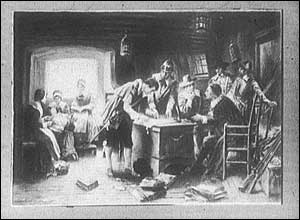
1636: Roger Williams founds Providence
The Massachusetts Bay Colony banishes Roger Williams, a radical clergyman who preaches freedom of religion and the separation of church and state. Williams and a small group of followers buy land from the Indians and establish Providence, Rhode Island. A beacon of religious liberty in early America, Rhode Island is at one time the only colony not to have anti-Quaker laws on its books.
1681: William Penn founds Pennsylvania
William Penn, a Quaker convert from a wealthy English family, obtains a colonial charter and founds Pennsylvania on land purchased from Indians. The colony becomes home not only to the much-persecuted Quaker minority — subject to exile and execution elsewhere for their anti-authoritarian and nonviolent views — but also to a wide range of other religious groups unwelcome in other colonies. Penn drafts a colonial constitution far ahead of its time, the Frame of Government, which codifies principles of religious liberty and the balancing of power across different branches of government.
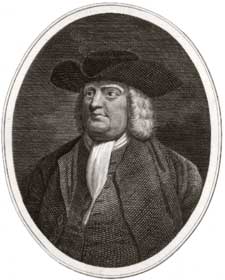
1779: Virgina Statute for Religious Freedom
Three years after penning the Declaration of Independence, Thomas Jefferson drafts the Virginia Statute for Religious Freedom. The statute forbids the government from dictating religious beliefs, arguing that “Almighty God hath created the mind free” and “civil rights have no dependence on our religious opinions, any more than our opinions in physics or geometry.” The Virginia General Assembly takes seven years to enact the statute, but Jefferson cites it in his epitaph as one of his three greatest achievements.
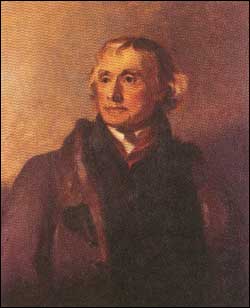
1787: Constitution
The Founding Fathers complete the Constitution, which states in Article Six that “no religious test shall ever be required as a qualification to any office or public trust under the United States.” Article Six also allows public officials to affirm, rather than swear, their support of the Constitution, a passage aimed at accommodating the Quaker minority, who were forbidden by their beliefs to swear oaths.
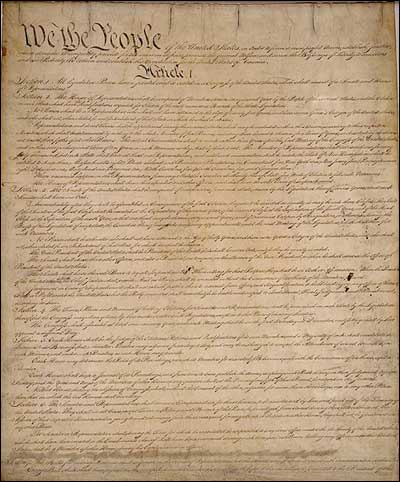
1791: First Amendment
Congress ratifies the Bill of Rights, whose First Amendment declares that “Congress shall make no law respecting an establishment of religion, or prohibiting the free exercise thereof.” These 16 words, the so-called establishment clause and free exercise clause, become the bedrock of constitutional law concerning the separation of church and state and the freedom of worship.
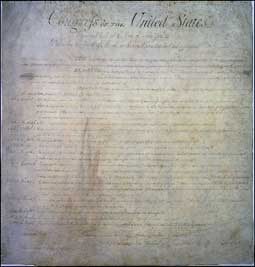
1797: Treaty of Tripoli
The U.S. Senate ratifies a treaty with Tripoli aimed at stopping Barbary pirates from terrorizing American shipping. The treaty declares that “the Government of the United States of America is not, in any sense, founded on the Christian religion.”
1802: “Separation of church and state”
Thomas Jefferson first used the phrase “building a wall of separation between church and state” to describe the First Amendment in a letter to the Danbury Baptist Association.

1827: Ezra Stiles Ely, Christian crusader
Presbyterian minister Ezra Stiles Ely preaches “The Duty of Christian Freemen to Elect Christian Rulers,” a sermon calling for the election of candidates who “know and believe the doctrines of our holy religion.” His movement amounts to a 19th-century version of the Christian Coalition, except that the early Christian political agenda focuses not on abortion or homosexuality, but on the evils of Sunday mail delivery.
1833: Last established church
The Commonwealth of Massachusetts officially rescinds support of an established church. It is the last state to do so. (At the time of the Revolution, most states had an official religion.)
1920: Prohibition
Decades of agitation by religiously inspired temperance activists culminates in the 18th Amendment, which bans the sale, manufacture, and transport of alcohol. Support for Prohibition is strongest among certain Protestant denominations, and the teetotaler cause brings together diverse constituencies, including the Women’s Christian Temperance Union, African American labor activists, and the Ku Klux Klan. Thirteen years later — after speakeasies mushroom throughout the country and illegal booze sales make gangsters rich — the amendment is repealed.
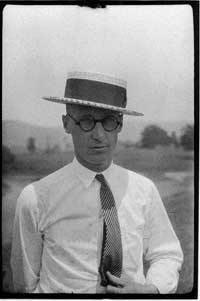
1925: The Scopes trial
John Scopes, a Tennessee high school teacher, violates a state law that bans teaching that “man has descended from a lower order of animals.” His trial unleashes a titanic struggle between supporters of creationism and evolution, who find their paladins in famed attorneys Clarence Darrow (for the defense) and William Jennings Bryan (for the prosecution). While trained chimpanzees parade outside the courthouse, inside the proceedings soon descend into a rambling discussion of what in the Bible is factual. Scopes loses and is levied a $100 fine, but the losers in the court of public opinion are Christian evangelicals, savaged by the press as “yokels” and “morons.”
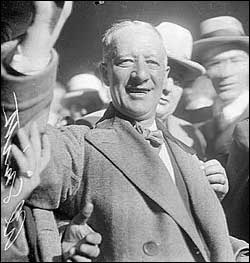
1928: Catholic runs for president
Al Smith, the Democratic governor of New York, becomes the first Roman Catholic to become a major party’s nominee for president. Facing allegations that he would be a pawn of the Pope, Smith declares his belief “in the absolute separation of church and state.” Smith’s candidacy is greeted with great hostility, including Ku Klux Klan cross-burnings, and Republican Herbert Hoover trounces Smith on Election Day.

1947: Court endorses “Wall of Separation”
In Everson v. Board of Education, the Supreme Court rules 5-4 that government funding to bring students to and from their parochial schools does not violate the First Amendment’s establishment clause. But this decision also said the Founders intended a “wall of separation” between church and state. “Neither a state nor the Federal Government can set up a church. Neither can pass laws which aid one religion, aid all religions or prefer one religion to another.”
1954: “Under God”
Congress adds the words “under God” to the Pledge of Allegiance.
1956: “In God We Trust”
A federal law establishes “In God We Trust” as the official motto of the United States. It appears on U.S. currency.
1960: Catholic wins presidency
John F. Kennedy, a Catholic, faces Richard Nixon in a closely fought presidential race. In an effort to defuse anti-Catholic sentiment, Kennedy gives a speech before a group of Protestant ministers in Houston, Texas, in which he states: “I believe in an America where the separation of church and state is absolute, where no Catholic prelate would tell the president (should he be Catholic) how to act, and no Protestant minister would tell his parishioners for whom to vote.” Two months later, Kennedy wins by a mere 0.1 percent margin in the popular vote.
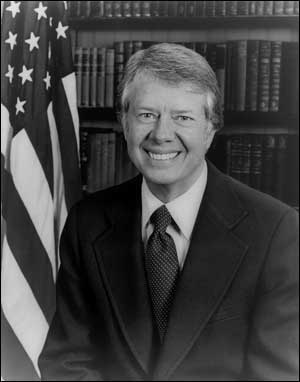
1962: Public school prayer banned
In Eagle v. Vitale, the U.S. Supreme Court prohibited prayer in the public schools as a way to prevent “the indirect coercive pressure” that occurs “when the power, prestige and financial support of government is placed behind a particular religious belief.”
1976: Jimmy Carter, evangelical president
Jimmy Carter, a born-again Christian, is elected president of the United States, bringing evangelical faith out of the political wilderness. In a Playboy interview published weeks before his election victory, Carter admits to having looked on women with “lust” and having committed adultery in his “heart.”
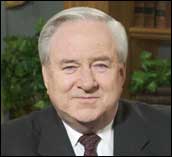
1979: Moral Majority
Televangelist Jerry Falwell founds Moral Majority, a conservative Christian political organization that fervently opposes abortion, gay rights, the Equal Rights Amendment, and arms talks with the Soviet Union. With a membership in the millions at its peak, Moral Majority dominates an ascendant Republican Party throughout the 1980s, transforming the Religious Right into the establishment voice of American evangelicism and a potent force in national politics.
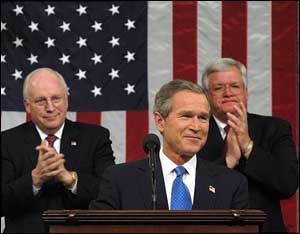
1987: Religious expression permitted in public places
The Supreme Court throws out a ban by the Los Angeles airport on leafleting by members of Jews for Jesus. This is the first of several “free speech” rulings over the next two decades that allow religious expression in public or even government settings, as long as it is initiated by private individuals or groups, rather than government officials. The Court ruled, for example, that a Christian student club in an Omaha public high school could meet after class.
2003: George Bush, “compassionate conservative”
President George W. Bush, a self-identified “compassionate conservative” strongly favored by evangelical Christian voters, says that God told him to invade Afghanistan and Iraq. Four months after the U.S.-led invasion of Iraq, Bush announces to a Palestinian delegation that the Almighty spoke to him with the words “George, go and fight these terrorists in Afghanistan” and “George, go and end the tyranny in Iraq.”
{mosimage}
Victor Tan Chen Victor Tan Chen is In The Fray's editor in chief and the author of Cut Loose: Jobless and Hopeless in an Unfair Economy. Site: victortanchen.com | Facebook | Twitter: @victortanchen
- Follow us on Twitter: @inthefray
- Comment on stories or like us on Facebook
- Subscribe to our free email newsletter
- Send us your writing, photography, or artwork
- Republish our Creative Commons-licensed content

